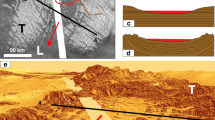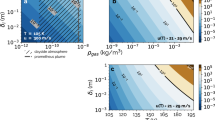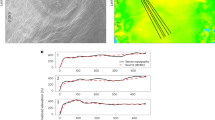Abstract
Observations of the south pole of the Saturnian moon Enceladus revealed large rifts in the south-polar terrain, informally called ‘tiger stripes’, named Alexandria, Baghdad, Cairo and Damascus Sulci. These fractures have been shown to be the sources of the observed jets of water vapour and icy particles1,2,3,4 and to exhibit higher temperatures than the surrounding terrain5,6. Subsequent observations have focused on obtaining close-up imaging of this region to better characterize these emissions. Recent work7 examined those newer data sets and used triangulation of discrete jets3 to produce maps of jetting activity at various times. Here we show that much of the eruptive activity can be explained by broad, curtain-like eruptions. Optical illusions in the curtain eruptions resulting from a combination of viewing direction and local fracture geometry produce image features that were probably misinterpreted previously as discrete jets. We present maps of the total emission along the fractures, rather than just the jet-like component, for five times during an approximately one-year period in 2009 and 2010. An accurate picture of the style, timing and spatial distribution of the south-polar eruptions is crucial to evaluating theories for the mechanism controlling the eruptions.
This is a preview of subscription content, access via your institution
Access options
Subscribe to this journal
Receive 51 print issues and online access
$199.00 per year
only $3.90 per issue
Buy this article
- Purchase on Springer Link
- Instant access to full article PDF
Prices may be subject to local taxes which are calculated during checkout




Similar content being viewed by others
References
Porco, C. C. et al. Cassini observes the active south pole of Enceladus. Science 311, 1393–1401 (2006)
Hansen, C. J. et al. Enceladus’ water vapor plume. Science 311, 1422–1425 (2006)
Spitale, J. N. & Porco, C. C. Association of the jets of Enceladus with the warmest regions on its south-polar fractures. Nature 449, 695–697 (2007)
Hansen, C. J. et al. Water vapour jets inside the plume of gas leaving Enceladus. Nature 456, 477–479 (2008)
Spencer, J. R. et al. Cassini encounters Enceladus: background and the discovery of a south polar hot spot. Science 311, 1401–1405 (2006)
Howett, C. J. A., Spencer, J. R., Pearl, J. & Segura, M. High heat flow from Enceladus’ south polar region measured using 10–600 cm−1 Cassini/CIRS data. J. Geophys. Res. 116, E03003 (2011)
Porco, C. C., DiNino, D. & Nimmo, F. How the geysers, tidal stresses, and thermal emission across the south polar terrain of Enceladus are related. Astron. J. 148, 45 (2014)
Porco, C. C. et al. Cassini imaging science: instrument characteristics and anticipated scientific investigations at Saturn. Space Sci. Rev. 115, 363–497 (2004)
Roatsch, T. J. et al. in Saturn from Cassini-Huygens (eds Dougherty, M. Esposito, L. & Krimigis, S. ) 763–781 (Springer, 2009).
Acknowledgements
This work was funded by grant number NNX13AG45G of the Cassini Data Analysis and Participating Scientists Program. We thank M. Hedman, P. Thomas and C. Howett for conversations on this topic.
Author information
Authors and Affiliations
Contributions
J.N.S. devised the approach and wrote the majority of the text. T.A.H. and A.R.R. contributed substantially to the interpretation and to the text. E.E.B. and S.S.P. digitized many of the fractures and contributed to early efforts that led to the current approach.
Corresponding author
Ethics declarations
Competing interests
The authors declare no competing financial interests.
Extended data figures and tables
Extended Data Figure 1 Portion of image N1602274088 showing source locations inferred from anomalous emission near Damascus Sulcus.
Diamonds are sample points inferred from the observed curtains; uncertainties are shown as circles about each displayed sample point. The inferred source locations correspond well with features that are not apparent in the base map.
Rights and permissions
About this article
Cite this article
Spitale, J., Hurford, T., Rhoden, A. et al. Curtain eruptions from Enceladus’ south-polar terrain. Nature 521, 57–60 (2015). https://doi.org/10.1038/nature14368
Received:
Accepted:
Published:
Issue Date:
DOI: https://doi.org/10.1038/nature14368
This article is cited by
-
Enceladus as a potential oasis for life: Science goals and investigations for future explorations
Experimental Astronomy (2022)
-
Ice-Ocean Exchange Processes in the Jovian and Saturnian Satellites
Space Science Reviews (2020)
-
Circumplanetary Dust Populations
Space Science Reviews (2019)
-
Comets, Enceladus and panspermia
Astrophysics and Space Science (2018)
-
Dust Emission by Active Moons
Space Science Reviews (2018)
Comments
By submitting a comment you agree to abide by our Terms and Community Guidelines. If you find something abusive or that does not comply with our terms or guidelines please flag it as inappropriate.



